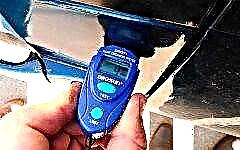

The content of the article:
- What are the thickness gauges
- How does paintwork thickness gauge work
- How to choose a device
- What to look for
The thickness gauge is a device with which you can easily and quickly calculate the thickness of the paintwork. Thickness gages are especially popular with the used car buying / selling professional. But for ordinary car enthusiasts, they will also be useful when buying a used car.
With the help of a paint and varnish thickness gauge, you can get information about the real condition of the car when buying: detect corrosive areas, as well as repainted areas with a layer of putty.
The thickness gauge will be especially useful when you have to deal with unscrupulous sellers trying to hide information about damage to the body and its repair after an accident. In addition, a paint-and-lacquer thickness gauge allows you to assess the condition of the machine much better than a professional expert who does not use such a device.
What are the thickness gauges

Before you start choosing a paintwork thickness gauge, you need to know what they are and what characteristics they have. Today the market offers a large number of a wide variety of thickness gauges from simple inexpensive (budget) to expensive professional ones with advanced functionality.
Conventionally, thickness gauges can be divided according to the principle of operation, depending on which several types of thickness gauges are distinguished:
- Magnetic. The simplest and cheapest devices for the price, based on the joint operation of a magnet and several sensors. When the device is brought to the surface of a metal body, it is attracted by a magnet, and special sensors in the device determine the force of attraction. Further, based on the obtained data on the force of attraction, the device calculates the thickness of the paintwork. Of course, the smaller the distance between the magnet and the metal, the stronger the gravitational force will be. The disadvantages of magnetic thickness gauges include a rather significant measurement error.
- Electromagnetic. More expensive and accurate devices based on the principle of electromagnetic induction or with Hall sensors. Thickness gauges of this type are distinguished by a fairly high measurement accuracy, but are intended only for measuring paintwork on iron surfaces that do not contain non-ferrous metals.
Accordingly, the electromagnetic thickness gauge is not suitable for measuring paintwork on aluminum, which is often used in expensive car brands (aluminum hood cover, various body inserts). The most popular models of electromagnetic thickness gauges: CHY113, ET10P, ET110.
- Eddy current. Unlike electromagnetic thickness gages, eddy current ones are able to measure the thickness of paintwork on a larger number of materials. However, they have their own peculiarity - the highest accuracy of measuring paintwork is obtained on body elements with high conductivity. For example, an eddy current thickness gauge is able to determine the thickness of the paint and varnish coating on an aluminum or copper surface without error.
But measuring the thickness of the paintwork on an ordinary iron surface will give a much worse result, with a large error. Another disadvantage of eddy current thickness gages is their high sensitivity to moisture, which is why the measurement often ends with a "short circuit" of the electrodes when working in conditions with high humidity. In addition, they have a fairly large working area, from which it is difficult to measure on a curved surface.
- Ultrasonic. This type of thickness gauges can be attributed to the most expensive, professional and universal (or combined) devices that allow you to measure paintwork on any materials (metal body parts, bumpers, decorative plastic inserts, etc.). The most popular models of universal thickness gauges: CHY115, ET11P, ET111
How does paintwork thickness gauge work

There is nothing complicated in the operation of the thickness gauge, except for periodic calibration (adjustment) of the device before use. Typically, to calibrate the thickness gauge, special plates are used, which are supplied in the sales kit with the device. And the calibration method (how to install and which buttons to press) is described in detail in the instructions for the device.
The thickness of the paintwork is approximately the same for all manufacturers and ranges from 100 to 140 microns. Therefore, when the thickness gauge, when measuring, gives a result in the specified range, it can be concluded that the measured element was not straightened, not putty or repainted after an accident.
If, when measuring, the thickness gauge shows a result above the specified range (200 microns or more), then it can be argued that the measured area of the body was once deformed during an accident and was restored.
By the way, even if the body element was completely changed and painted in a car service, then the "car service" thickness of the paintwork will also significantly differ from the factory one in a larger direction. And if the car service has saved a lot on the primer, then it is possible to get the opposite result, downward (less than 100 microns).
The car body is designed in such a way that when it deforms during an accident, passengers are injured as little as possible. The danger of acquiring a car that has been in an accident is not only that, over time, damaged and restored (repainted) body parts begin to rust, but also that it is not known how a previously deformed body with a broken geometry will behave.
Of course, accidents can be different - from a banal small dent or scratch during parking maneuvers to serious damage with a strong impact at high speed. And here, at the most opportune time, a thickness gauge will be useful, which will help determine the severity of damage by the thickness of the paintwork.
How to choose a device

When choosing a paint coating thickness gauge, remember that there is no perfect device suitable for everyone. First of all, to choose the right thickness gauge without overpaying extra money, you need to answer a few questions:
- How often do you plan to use the thickness gauge? Rarely when buying a used car for yourself? Or do you work in the auto business and buy / sell used cars every day?
- Which car brands are you planning to check: expensive or cheap? For example, such expensive cars as "Mercedes", "BMW", "Volvo" "Audi" have non-ferrous metals (most often aluminum) in their bodies, so they will need a thickness gauge capable of working with non-ferrous metals.
- How much are you planning to spend on the purchase? If you are an ordinary car owner, then devices from the middle price category will be preferable for you, since the cheapest devices have not only poor workmanship, but also give a large measurement error.
In turn, the most expensive devices can have extensive functionality that is of interest only to professionals.
Also, do not forget that the high cost of the device is often due to the popularity of a well-known brand (trade mark) of the manufacturer. That is, you will simply overpay for the promoted "name", whereas you can buy a thickness gauge of the same quality and with the same set of functions, but from another manufacturer and at a lower price.
It is not difficult to determine the average price for thickness gauges - you just need to compare prices in popular online stores. There are also quite a few sites on the Internet that provide price comparisons in different stores. By comparing the minimum and maximum prices, you can easily calculate the average price category.
- What functions should a thickness gauge have? To determine this issue, first of all, you need to know on what materials you plan to measure paintwork (ordinary metal, non-ferrous metal, plastic, etc.).
- What shape and dimensions should the thickness gauge have? For example, most pistol-shaped thickness gauges are large enough and not always convenient for use in hard-to-reach areas of the body. Conversely, the thickness gauge in mobile phone format is more compact and convenient for use in hard-to-reach places and on curved surfaces.
Additionally, it is recommended to read reviews on the Web for various models of thickness gauges. It is even better if you have friends who already have experience with these devices and can give practical tips and tricks from the first person perspective.
What to look for

After choosing a model of a thickness gauge with a suitable principle of operation, a set of functions and a price, you should pay attention to the following factors:
- Battery. If the thickness gauge is planned to be used continuously for a long time, then the best option would be a device with an autonomous energy-intensive battery.
- Model with push-button sensor or trigger (pistol version). The pistol version of the device, with a trigger, lasts longer and is more reliable than its push-button counterparts. However, as mentioned above, the pistol version of the thickness gauge is relatively large and inconvenient when measuring paintwork in hard-to-reach places.
- Display (screen) size. Devices with a large screen will be especially convenient when working in rooms with low light or for users with low vision. As a general rule, the larger the display of the instrument, the more data it contains.
Conclusion
The paint thickness gauge will be a bargain, which almost always pays off when buying a used car. This device will become an indispensable assistant for detecting various invisible defects, which are silent about an unscrupulous seller trying to sell a "pig in a poke".
The detection of hidden defects using a thickness gauge will help not only assess the real condition of the car, but also force an unscrupulous seller to reduce the price of the equipment being sold.
By the way, the thickness gauge can come in handy not only when buying a used, but also a new car. Indeed, according to statistics, about 30% of new cars are damaged during transportation, which is why they then have to be putty and repainted.











